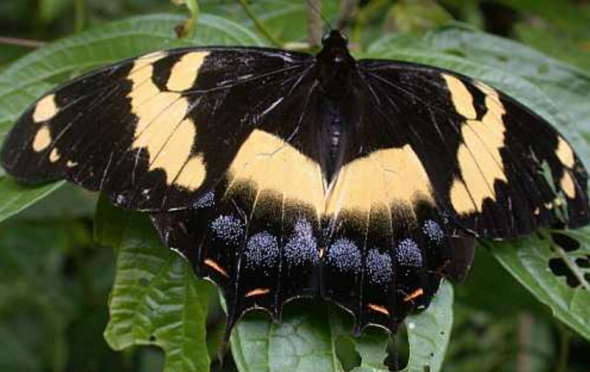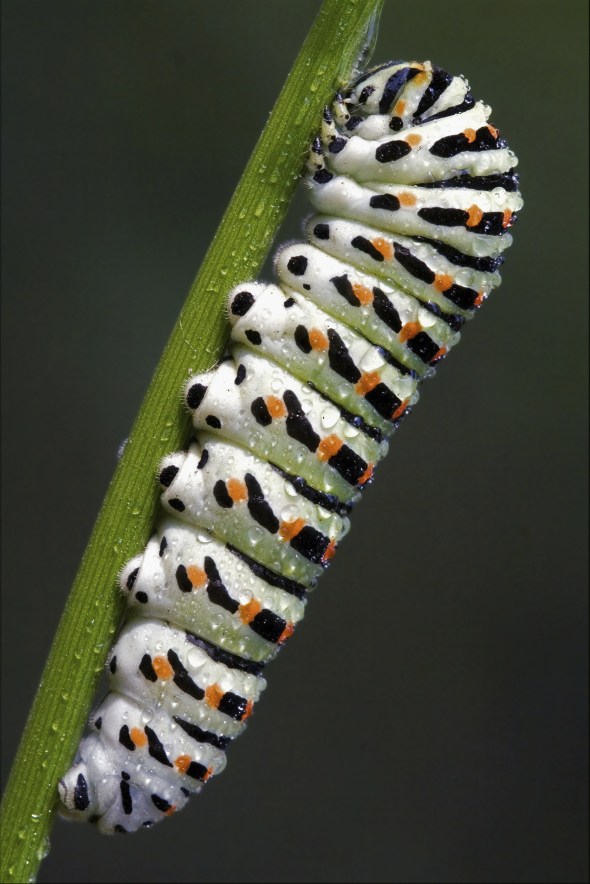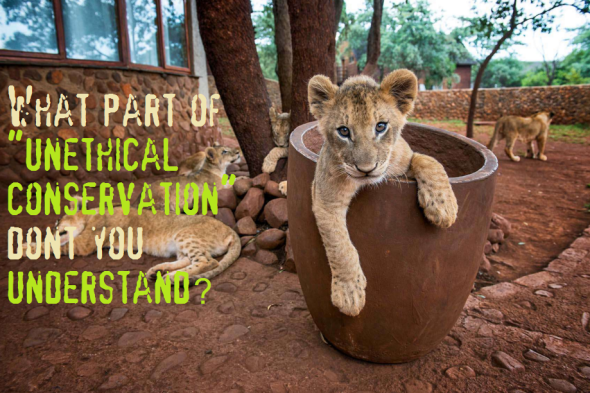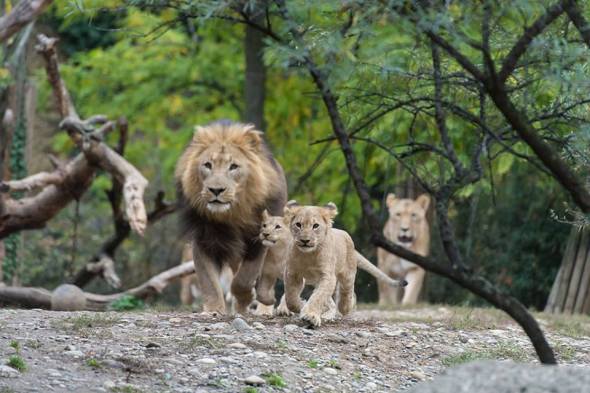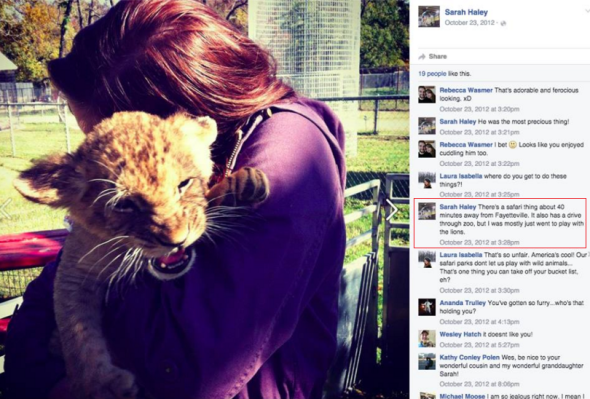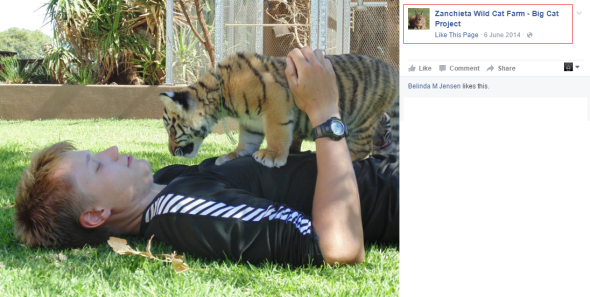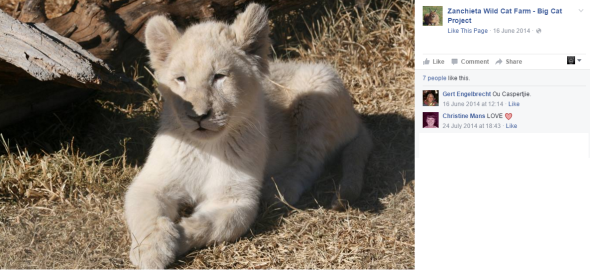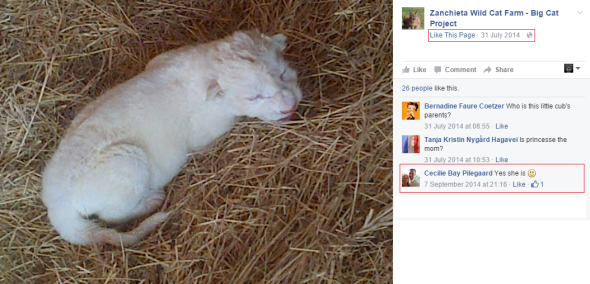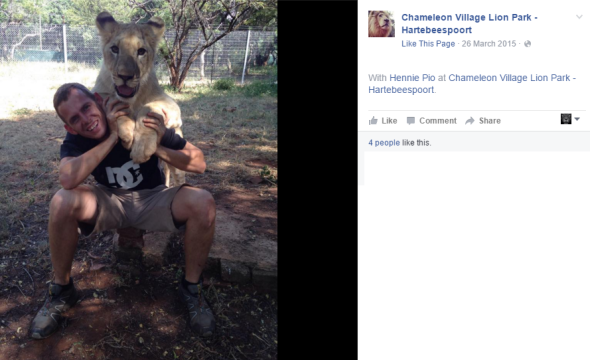ENDANGERED SPECIES MONDAY | PHOCARCTOS HOOKERI EXTINCTION LOOMING - NATIONAL EMERGENCY.
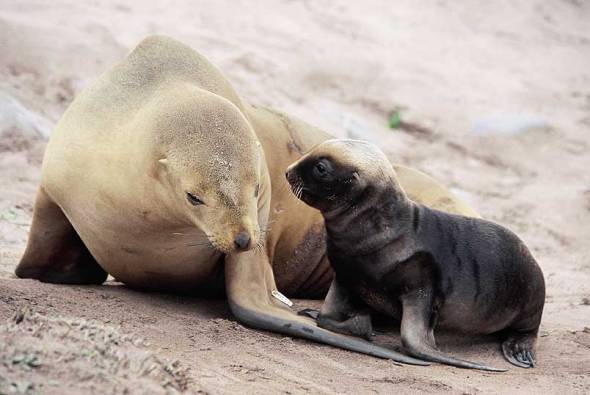
ENDANGERED SPECIES MONDAY | PHOCARCTOS HOOKERI
This Monday’s endangered species (E.S.P.) article I’ve chosen to document on the New Zealand sea lion. Image: New Zealand Sea Lion. Credits: Tui De Roy.
Listed as (endangered) the species was identified by Dr Gray back in 1866. Dr Gray John Edward Gray, FRS (12 February 1800 – 7 March 1875) was a British zoologist. He was the elder brother of zoologist Dr George Robert Gray and son of the pharmacologist and botanist Dr Samuel Frederick Gray (1766–1828).
Dr Gray was Keeper of Zoology at the British Museum in London from 1840 until Christmas 1874, before the Natural History holdings were split off to the Natural History Museum published several catalogues of the museum collections that included comprehensive discussions of animal groups as well as descriptions of new species. He improved the zoological collections to make them amongst the best in the world.
Scientifically identified as the Phocarctos hookeri the species was listed as vulnerable from 1994-2008. Unfortunately due to continued population declines the New Zealand seal is now bordering complete extinction within the wild (and things really aren’t looking good neither) Endemic to Australia (Macquarie Is.); and New Zealand (South Is.), the species is also native to the Pacific North West.
To date there is estimated to be no fewer than 3,031 mature individuals remaining within the wild. New Zealand sea lions are one of the largest New Zealand animals. Like all otariids, they have marked sexual dimorphism; adult males are 240–350 cm long and weigh 320–450 kg and adult females are 180–200 cm long aMnd weigh 90–165 kg. At birth, pups are 70–100 cm long and weigh 7–8 kg; the natal pelage is a thick coat of dark brown hair that becomes dark gray with cream markings on the top of the head, nose, tail and at the base of the flippers.
Adult females’ coats vary from buff to creamy grey with darker pigmentation around the muzzle and the flippers. Adult males are blackish-brown with a well-developed black mane of coarse hair reaching the shoulders. New Zealand sea lions are strongly philopatric.
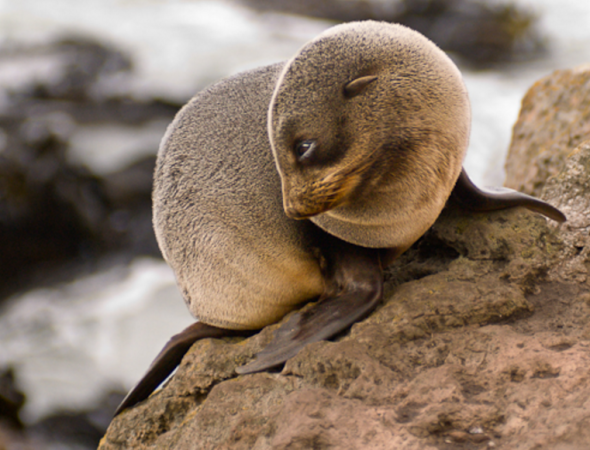
Image: New Zealand Sea Lion Pup. Credits: NZ Fur Seals.
Back in 2012 populations of New Zealand sea lions “were estimated to be standing at a population count of 12,000 mature individuals”. However since that count took place, from (2014) populations have ‘allegedly plummeted’ to all new levels although there doesn’t appear to be any evidence as to why the species suddenly declined - fish trawling and disease have been noted though!.
Like the Maui’s dolphin, the sea lion has come under intense scrutiny this year after research showed its numbers had halved since 1998. It has been classed as nationally critical and if its decline is not stemmed will be extinct within 23 years. A bacterial infection severely reduced breeding in 1997-98, and the species has failed to recover.
Its decline has been compounded by deaths due to squid fisheries, which trawl at a similar depth to the sea lions’ hunting grounds. Conservation groups call the population decline “a national emergency and are calling on stricter by-catch limits and a change in fishing methods”.
BACK IN 2012 THE NEW ZEALAND HERALD REPORTED THE FOLLOWING
In a country with 2800 threatened species, conservation in New Zealand is often about picking winners. The Department of Conservation’s budget and energy can extend only to active interventions for 200 of these endangered species.
Whether a species is protected depends on funding, community input, national identity and research. DoC spokesman Rory Newsam says interventions are often made because the department believes it can “get the most bang for its buck”. But animals and plants are not always invested in because they have a greater chance of survival.
The kakapo receives a relatively large chunk of funding despite being functionally extinct on the mainland. Some ecologists argue too much is spent rescuing the rare parrot, while more crucial parts of our ecosystem are left behind. But the kakapo is protected because it is a charismatic species and the public considers it integral to New Zealand’s ecological identity.
Conservationists say kakapo are a window to New Zealand’s history. They are believed to have inhabited the Earth for millions of years. To kill them off in a fraction of that time is an indictment on the way we live.

Image: New Zealand Sea Lion. Image Credits One Newz.
New Zealand sea lions are known to predate on a wide range of prey species including fish (e.g. hoki and red cod), cephalopods (e.g. New Zealand arrow squid and yellow octopus), crustaceans, seabirds and other marine mammals. Studies indicate a strong location effect on diet, with almost no overlap in prey species comparing sea lions at Otago Peninsula and Campbell Island, at the north and south extents of the species’ breeding range. New Zealand sea lions are in turn predated on by great white sharks, with 27% showing evidence of scarring from near-miss shark attacks in an opportunistic study of adult NZ sea lions at Sandy Bay, Enderby Island.
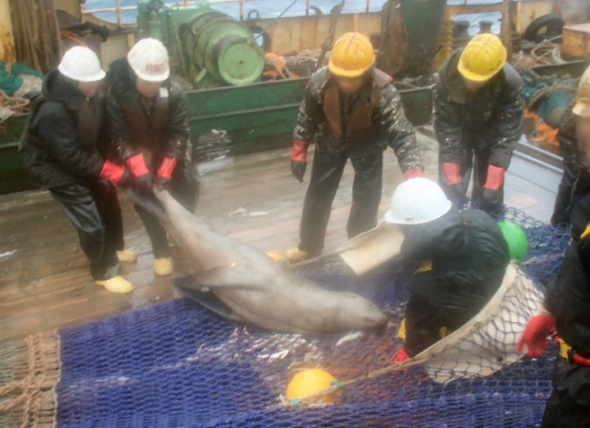
Image: Dead New Zealand Sea Lion in Fishing Net.
Since 2012 New Zealand conservationists, and the public community have been calling on the New Zealand government to do everything they possibly can to preserve this species. Unfortunately as you can see above fishermen are still accidentally killing the species off. As the species is protected under law and listed as endangered, the New Zealand government must take action against these perpetrators, otherwise extinction will most certainly occur.
The Maori people of New Zealand have traditionally hunted Sea Lions, presumably since first contact, as did Europeans upon their arrival much later. Commercial sealing in the early 19th century decimated the population in the Auckland Islands, but despite the depletion sealing continued until the mid-20th century when it was halted.
Commercial sealing in the early 19th century decimated the New Zealand Sea Lion population in the Auckland Islands, but despite the depletion sealing continued until the mid-20th century. The population has yet to fully recover from the period of over exploitation. At the present time, New Zealand Sea Lions have a highly restricted distribution, a small population, and nearly all of the breeding activity is concentrated in two subantarctic island groups. This restricted and small breeding population in combination makes them vulnerable to disease outbreaks, environmental change, and human activities.
The commercial Arrow Squid trawl fishery near the Auckland Islands reported their first New Zealand Sea Lion bycatch mortalities in 1978. Reported or estimated mortality between 1995 and 2007 averaged 92 animals annually (range 17-143) which was 3.7% of the estimated number of mature individuals in the Auckland Island area. Of particular concern is that most bycatch animals are females (up to 91%). New Zealand Sea Lions are also incidentally caught in other trawl fisheries around the Auckland and Campbell Islands.
Apart from direct mortality, competition and habitat modification caused by fishing activity may also be impacting New Zealand Sea Lion foraging areas. Epizootic outbreaks at the Auckland Islands in 1998, 2002, and 2003 led to more than 50%, 33%, and 21% early pup mortality respectively, and were also responsible for the deaths of some animals from other age classes during 1998.
The source of the suspected bacterial agent and cause of the outbreak and subsequent mortality for the 1998 outbreak are unknown, however the 2002 and 2003 outbreaks have been identified as being caused by Klebsiella pneumoniae.
The future of the New Zealand sea lion doesn’t look good at all. I highly suspect that we’re going to lose the species within 10-20 years (if that). More needs to be done to preserve the species habitat and its current fishing grounds as well as protecting from bacterial outbreaks. Failing this the species will be extinct within 10-20 years max. I am highly doubtful here, which is very rare for me to speak about.
Thank you for reading.
Dr Jose C. Depre. PhD. MEnvSc. BSc(Hons) Botany, PhD(NeuroSci) D.V.M.
Environmental, Botanical & Human Scientist.
ENDANGERED SPECIES MONDAY | SUNDASCIURUS HIPPURUS
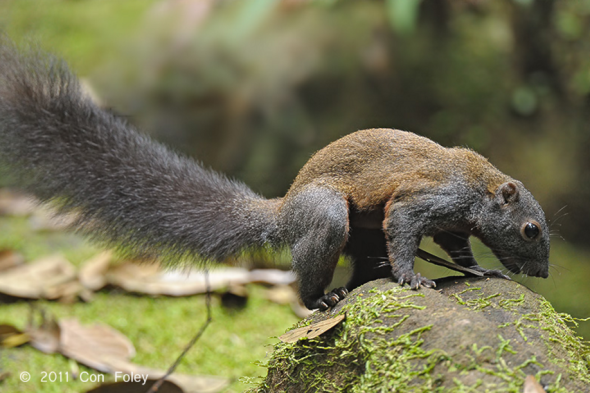
ENDANGERED SPECIES MONDAY | SUNDASCIURUS HIPPURUS
This Mondays (E.S.P) post - [Endangered Species watch Post] I am documenting on the horse tailed squirrel, scientifically identified as Sundasciurus hippurus. (Image: Horse tailed squirrel. Credits: Con Foley)
Listed as [near threatened] the species was first discovered back in 1831 by French Dr Étienne Geoffroy Saint-Hilaire (15 April 1772 – 19 June 1844) who was a French naturalist who established the principle of “unity of composition”. He was a colleague of Jean-Baptiste Lamarck and expanded and defended Lamarck’s evolutionary theories.
Geoffroy’s scientific views had a transcendental flavor (unlike Lamarck’s materialistic views) and were similar to those of German morphologists like Lorenz Oken. He believed in the underlying unity of organismal design, and the possibility of the transmutation of species in time, amassing evidence for his claims through research in comparative anatomy, paleontology, and embryology.
Dr Geoffroy ‘allegedly’ named the squirrel ‘the horse tailed squirrel’ because the squirrels tail resembled that of a horse tail, although even I myself find that somewhat difficult to digest, as in all due honesty the tail looks more like a bushy tail, which horses don’t really host. Horses tend to have long, slender and non-bushy tails, while others do host a type of busy but lose tail. I could be wrong?!
While as yet I cannot prove this, I do believe that Dr Geoffroy may have named the squirrel after a wild dwarf Asiatic horse endemic to South East Asia - that as yet we environmentalists have as yet to discover more about, furthermore that species of horse is likely to be extinct.
Moving on and (as explained) the horse tailed squirrel has been listed as [near threatened]. From 1996-2012 the species was placed into the category of [lower risk/least concern]. Lower risk/least concern is defined as: A taxon is Least Concern when it has been evaluated against the criteria and does not qualify for Critically Endangered, Endangered, Vulnerable or Near Threatened. Widespread and abundant taxa are included in this category.
International Animal Rescue Foundation Asian Environmental Scientists have been studying this species (among others) and can confirm from camera traps that the mammal’s populations are still declining significantly. However to what extent we’re still unsure.
As yet there have been ‘no reported extinctions’ within anyone of the species endemic countries being: Brunei Darussalam; Indonesia (Kalimantan, Sumatera); Malaysia (Peninsular Malaysia, Sabah, Sarawak) and Thailand. Since 2012 environmental fauna scientists have tried in vain to establish a mean population count, unfortunately as yet we (the organisation) and non-related organisations cannot determine a true population count.
Back in 2004 Dr’s Han and Giman pers. comm stated that the species was common, furthermore there was no evidence to prove the species was severely fragmented, or nearing endangered. The species prefers to inhabits lowland forests, however is also located in secondary forests too. Scientists reported that within these secondary forests species populations were on the decline.
Unlike your normal European squirrel the species can commonly be located at ground level foraging for food ranging from nuts, fruits, seeds and insects. Interestingly the species is diurnal (again unlike the European squirrel). Diurnal means the species will be active either during the day or night. Whereas the European squirrel is normally pretty active during the daytime, then rests during the night.
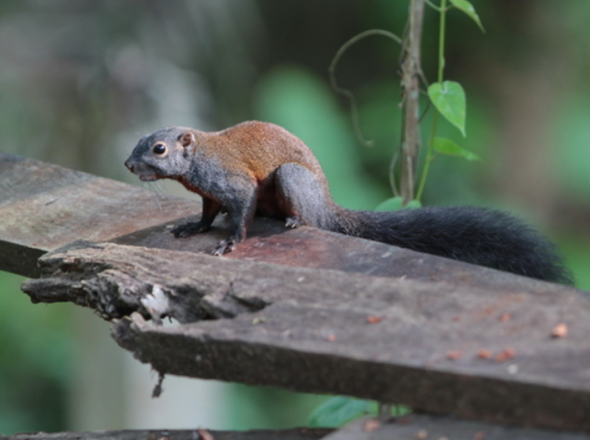
Image: Horse tailed squirrel: Photographer unknown
While the species ‘often lives within the trees’, horse tailed squirrels will spend a majority of their time at ground level. It has been suggested that one of the reasons for low densities of this species in Malaysian tropical rain forest is competition from the great variety of other arboreal vertebrates (such as birds, and especially primates) for food, especially fruits and leaves, which are among the food items preferred by squirrels.
There are by few very few threats actually known, however don’t take that as positive news. The species is threatened by habitat loss due to logging and agricultural conversion. I expect the first extinctions are likely to be witnessed within Malaysia (based on past and current research). Malaysian deforestation and palm oil plantations all pose a very high threat to the horse tailed squirrel as well as many other species of flora and fauna.
Nearly 60% of Malaysia is still covered with natural rain forest, unfortunately much of Malaysia forests are devoted to cash crop plantations, particularly oil palm and rubber, with tree crops occupying 17% of Malaysia’s land area. These are ideally suited to Malaysia’s hot, wet, and humid climate.
While many of us are aware of ‘palm oil devastation’ which is probably by far the biggest threat to a wide number of animals and plants - including the horse tailed squirrel. I would also like to point out to many non-meat and dairy consumers (I.e: Vegans), that while coconut plantations are for now considerably small. These plantations are still being developed and farmed within areas that once saw pristine green forests - now nothing more than a brown churned up heap of land growing and harvesting coconuts too.
In Malaysia, coconut is the fourth important industrial crop after oil palm, rubber and paddy in terms of total planted area. It is also one of the oldest agro-based industries. As an industry, coconut contributes very little to the overall economy of Malaysia (contribution to export earnings of about 0.08% in 2006).
Recent competition with oil palm for land has also resulted in the decline of the total area under coconut cultivation: in 2001, the area was about 151,000 ha and this has gradually decreased to the acreage of 109,185 ha in 2007. Based on the estimates given under the 9th Malaysia Plan, it is anticipated that the acreage will consolidate to around 80,000 ha by 2010. However regardless of this ‘alleged decline’ most if not all coconut plantations are farmed within forests where species such as the horse tailed squirrel is inhabiting.
The species is found in several protected areas, including Pasoh Forest Reserve. Environmentalists state the need for further comparative study on this species’ abundance, density and distribution and its relationship to forest structure or habitat quality, spatially and temporally, in hill dipterocarp forest of Malaysia is greatly needed.
For now the future of the horse tailed squirrel is uncertain. I’m doubtful the species will remain extant within Malaysia for much longer - with possible localized extinctions witnessed here soon. More research needs to be undertaken on the species, furthermore we also need to research just how much ‘pristine green forest is being converted for fruit, cereal crops, oils and plant milk crops’ rather than just palm oil. While I find palm oil agriculture incredibly concerning. Knowing that anyone of our vegan, vegetable and fruit crops is originating from areas where animals are being killed - is just as concerning too.
Thank you for reading.
Dr Jose C. Depre PhD. MEnvSc. BSc(Hons) Botany, PhD(NeuroSci) D.V.M.
Master of Environmental Botanical & Human Science.
(Environmental, Botanical & Human Scientist).
Endangered Species Monday | Tasmanian Devil | Sarcophilus harrisii.
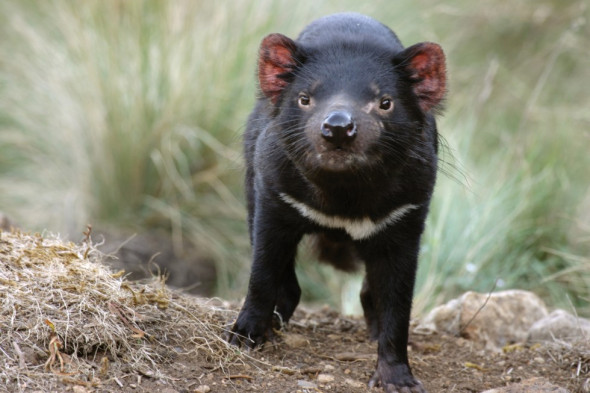
ENDANGERED SPECIES MONDAY | TASMANIAN DEVIL
This Mondays endangered species watch post (ESP) is dedicated to the Tasmanian devil, an endangered carnivorous marsupial that’s roughly the same size as a small domesticated canine. (Image credits: Bicheno Tasmania tourism)
The Tasmanian devil was formally identified back in 1841 by ‘French’ Dr Pierre Boitard (27 April 1787 Mâcon, Saône-et-Loire – 1859) whom was a French botanist and geologist. As well as describing and classifying the Tasmanian devil, he is notable for his fictional natural history Paris avant les hommes (Paris Before Man), published posthumously in 1861, which described a prehistoric ape-like human ancestor living in the region of Paris. He also wrote Curiosités d’histoire naturelle et astronomie amusante, Réalités fantastiques, Voyages dans les planètes, Manuel du naturaliste préparateur ou l’art d’empailler les animaux et de conserver les végétaux et les minéraux, and Manuel d’entomologie etc.
Listed as (endangered), and scientifically identified as Sarcophilus harrisii. Back in 1996 conservation scientists undertook further research on the species thus concluding the species was of ‘lower risk’. Unfortunately since 1996 - things have changed dramatically on the Australian continent. From the middle 1990’s conservationists estimated the mean mature individual total as being - 130,00-150,000 mature individuals.
Spotlighting sightings of Tasmanian devils across the state have declined significantly since the emergence of Devil Facial Tumour Disease (DFTD) in the mid-1990s: by 27% by early 2004, by 41% by early 2006, by 53% by early 2007, and by 64% by early 2008. The decline was significantly sharper in regions where DFTD had been reported earliest, such that in north-east Tasmania, mean sightings have declined by 95% from 1992-1995 to 2005-2007, with no indication of recovery or plateau in decline.
Comparison of mark-recapture results in the same area from the mid-1980s and 2007 supports this finding. At the Freycinet peninsula, on the east coast of Tasmania, where the population has been monitored through trapping from 1999 to the present, the population has declined by at least 60% since the disease was first detected in 2001 and the adult population still appears to be halving annually. Other indicators of devil abundance, such as road kills, predation on stock, and carrion removal, also support this conclusion of a substantial decline.
Surveys conducted back in 2007 ‘estimate the (mature) Tasmanian devil populations to be standing 25,000 being the highest estimate’; this equates to around 50,000 individuals. However back in 2004 conservationists stated the (mature populations) could be as low as 21,000 mature individuals. Conservationists have confirmed that due to the rapid spread of Devil Facial Tumor Disease, and other threats such as road accidents and predator kills - acknowledging these provisos, the best estimate of total population size based on current evidence thus lies within the range of 10,000-25,000 mature individuals. Based on threats, gestation, life span this therefore qualifies the species to be entered into [endangered category].
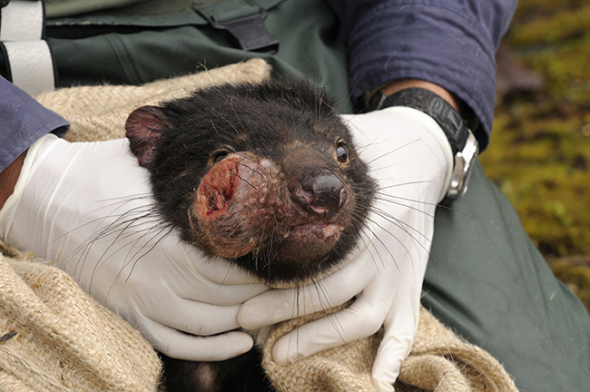
13 Feb 2011, Cradle Mountain-Lake St. Clair National Park, Tasmania, Australia — Tasmanian Devil (Sarcophilus harrisii) being treated by scientist for DFTD, Devil Facial Tumor Disease. This is a cancer that is spread by biting or physical contact from one animal to another, Cradle Mountain, Tasmania, Australia. — Image by © Dave Wattsl/Visuals Unlimited/Corbis.
In North-Western Australia Tasmanian devil populations are estimated to be standing at between (3,000-12,500 individuals). Meanwhile - in Eastern South Western Australia populations are said to be standing at 7,000 12,500 individuals.
Other trapping work by the Department of Primary Industry and Water (DPIW) Save the Tasmanian Devil Program broadly support these predictions for DFTD-free regions. However, in central and eastern regions, marked population declines have been detected, in association with the earlier reports of Devil Facial Tumour Disease (DFTD), subsequent to the time of the Jones and Rose survey. The north-west region is thus now thought to support the highest population densities.
The species is not known to be seriously or severely fragmented, however populations on the decline and fast, primarily due to Devil Facial Tumor Disease.
THREATS
Current evidence suggests that DFTD is an infectious, widespread disease, so that any attempt to delineate boundaries between affected and unaffected locations is likely to be outdated swiftly. DFTD has been associated with local population declines of up to 89% since first reported (Hawkins et al. 2006, McCallum et al. 2007), indicated by long-term spotlighting data, widespread trapping and laboratory results. The declines, and the prevalence of the disease, have not eased off in any monitoring sites, and DFTD is present even in very low density areas.
It is estimated that the adult population is approximately halving annually on the Freycinet peninsula with extinction predicted at this site 10-15 years after disease arrival. Declines were most marked in areas where the disease had been reported earliest, in north-eastern and central eastern Tasmania.
Mean spotlighting sightings of Tasmanian devils per 10 km route, obtained from across the core Tasmanian devil range (eastern and north-western Tasmania), have declined by 53% since the first report of DFTD-like symptoms in 1996. The most immediately threatened location is thought to be the region where DFTD was reported prior to 2003: across 15,000 km² of eastern Tasmania.
By 2005, the Devil Disease Project Team had confirmed DFTD in individuals found across 36,000 km² of eastern and central Tasmania. DFTD is now confirmed across more than 60% of the devil’s overall distribution, and there is evidence for continued geographical spread of the disease, so that Tasmanian devils across between 51% and 100% of Tasmania may be, or have already been, subject to >90% declines in a ten-year period. The currently affected region covers the majority of the formerly high-density eastern management unit, involving what was perhaps around 80% of the total population.
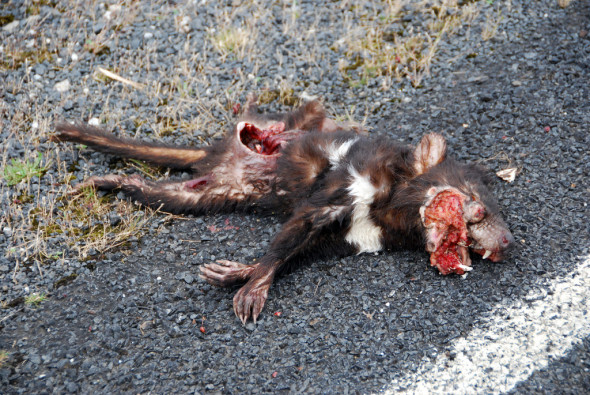
Image: Tasmanian devil killed by car/with suspected DFTD.
DTFD has resulted in the progressive loss of first the older adults from the population and then the younger adults so that populations are comprised of one and two year old’s. As female devils usually breed for the first time at age two, they may not successfully raise a litter before they die of DFTD. An increase in precocial breeding indicates some compensatory response, but as yet this appears to have been insufficient to counter mortality.
DFTD behaves like a frequency-dependent disease, probably because the majority of the injurious biting, which is the type of contact most likely to lead to disease transmission, occurs between adults during the mating season. Frequency-dependent diseases, which are typically sexually transmitted, can lead to extinction. Because transmission occurs between the sexes at mating irrespective of population density, these types of diseases lack a threshold density below which they become extinct.
Cannibalism is considered fairly common in Tasmanian devils and renders the species particularly vulnerable to disease transmission. However, modes of transmission of DFTD are not as yet known.
ROAD KILLS:
A recent three-year study of roadkill frequency on the main roads of Tasmania estimated 2,205 Tasmanian devils are killed on roads annually. This suggests that 2-3.% of the total Tasmanian devil population are killed on roads (based on an estimated population of 60,000–90,000 individuals at the time of the survey). The roaded parts of Tasmania closely match the core distribution area for Tasmanian devils.
Roadkill was attributed as the cause of up to 50% and 20% of Tasmanian devil death during a recording period of 17 months at Cradle Mountain and 12 months at Freycinet National Parks, respectively. Local extinction and a similar rate of population decline at Cradle Mountain indicates that roadkill can cause local extinction, in which the road becomes a local sink. Future impact is likely to remain at the same level.
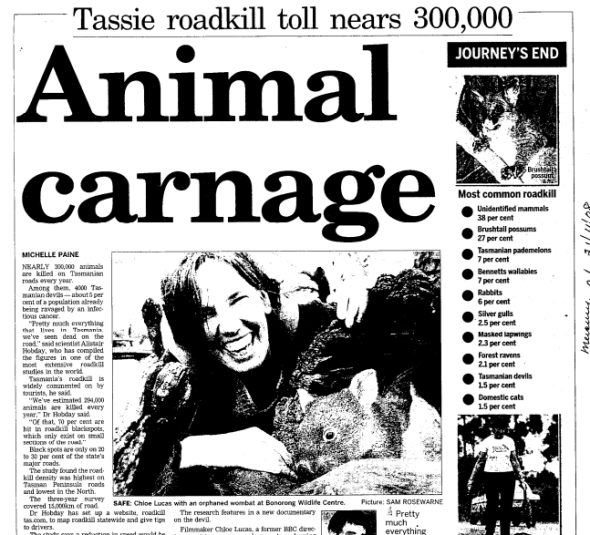
Image: Paper cutting relating to 3 year study of fauna road kill.
DOG KILLS:
Reports of about 50 devils killed per year by poorly controlled dogs are served from about 20 dog owners. There is no obligation or incentive for such reports, and generally some hesitance even among those providing them, so the real figures are more likely of the order of several hundred devils killed by dogs each year.
FOXES:
There have been spasmodic, small-scale introductions of the Red Fox (Vulpes vulpes) into Tasmania since early European colonisation. Early incursions were sometimes efforts at acclimatisation and others for short-term hunting. More recently, there has been at least one accidental incursion (from a container ship in 1998) and credible reports of a concerted, malicious campaign of introduction.
Hard evidence (confirmed scats, carcasses) of foxes has been found in the north-west and northern and southern midlands. Credible sighting reports have come from most of the eastern half of the State including the central highlands and the far north-west, mostly areas where Tasmanian devil populations are suppressed by DFTD.
A commonly held view has been that the abundance of Tasmanian devils has prevented fox establishment through interference competition, either aggressive exclusion or predation on denned juveniles. Red Foxes and Tasmanian devils share preferences for den sites and habitat, and are of a similar size. Tasmanian devils abundance is likely to slow, if not prevent, fox establishment.
It is possible that foxes have been present in Tasmania for many decades at sub-detectable levels, and that a degree of ecological release has occurred due to DFTD, with foxes increasing to detectable numbers. The current impact of the Red Fox has been quantified, and it is unlikely that fox numbers are currently at a level to impose a measurable impact.
A decline in Tasmanian devils number may create a short to medium-term surplus of food, for example carrion; ideal for fox establishment. Fox establishment may cause both direct and indirect effects on Tasmanian devils. Direct effects include (reciprocal) killing by then abundant foxes of then rare juvenile devils at dens while the female forages.
Fox establishment may also cause ecosystem disruptions through changes in other species - a feature of foxes on mainland Australia and something that might then also indirectly affect Tasmanian devils. Tasmania has the potential to hold up to 250,000 foxes (based on modelling of habitat preferences and densities in south-east mainland Australian) which could replace most medium- to large-sized marsupial carnivores.

Image: Red foxes have been reported to prey on Tasmanian devils/Other Marsupials.
PERSECUTION:
In the past, persecution of the Tasmanian devil has been very high throughout settled parts of Tasmania, and is thought to have brought about very low numbers at times. Through the 1980s and 1990s, systematic poisoning in many sheep-growing areas (particularly fine-wool with its reliance on merinos) was widespread and probably killed in excess of 5000 devils per year. In the 1990s, control permits were occasionally issued to individuals who were able to argue that Tasmanian devils were pests (e.g. killing valuable lambs).
Current persecution is much reduced, but can still be locally intense with in excess of 500 devils thought to be killed per year. However, this is reducing since devil numbers have declined. While the small amount of current persecution is likely to persist it is unlikely to constitute a major threat unless the Tasmanian devil population becomes extremely small and fragmented.
LOW GENETIC DIVERSITY:
Dr Jones in 2004 found the genetic diversity of Tasmanian devils to be low relative to many Australian marsupials as well as placental carnivores. This was consistent with an island founder effect, but previous marked reductions in population size may also have played a role. Low genetic diversity can reduce population viability, and resistance to disease.
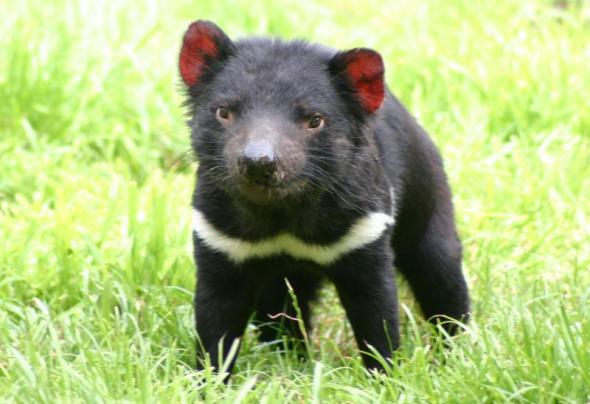
Image: Tasmanian devil (photographer unknown).
Tasmanian devils normally eat birds, snakes, fish, reptiles and insects. Furthermore its not uncommon to witness the species feasting on dead carrion. Female devils will mate with dominant males, who fight to gain their attention. Three weeks after conception, the females ‘can’ give birth to up to FIFTY BABIES, called joeys, although some reports state between 20-30 joeys. These extremely tiny joeys scramble to attach themselves to one of the four available teats in the mother’s pouch. Gestation is around 21 days.
For now the future is uncertain with regards to the Tasmanian devil. The species hosts a large number of natural threats, as well as roadkill accidents, human persecution and (DFTD). For now populations are considered to be generally high, although not that high for the species to qualify as vulnerable, or even near threatened. There are a number of Australian marsupials facing many threats, despite the continent being inhabited at some 10% by humans, or to be precise - 768,685 km2.
While I myself cannot state for certain what the future may hold for the Tasmanian devil - for now based on the large number of threats and continued population declines - its highly likely that come 2026 we’ll be seeing yet another Australian extinction occurring under our noses, and that is the sad reality of life from which our wildlife is facing today.
One thing is for sure though - never underestimate the DEVIL - they’re not called devils for nothing and have a rather cute temper too. Welcome to the planets largest carnivorousness marsupial. The Tasmanian devil
Thank you for reading.
Dr Jose C. Depre PhD. MEnvSc. BSc(Hons) Botany, PhD(NeuroSci) D.V.M.
Master Scientist of Environmental, Botanical & Human Science
Endangered Species Monday | Potorous gilbertii - Back From The Brink Of Extinction.
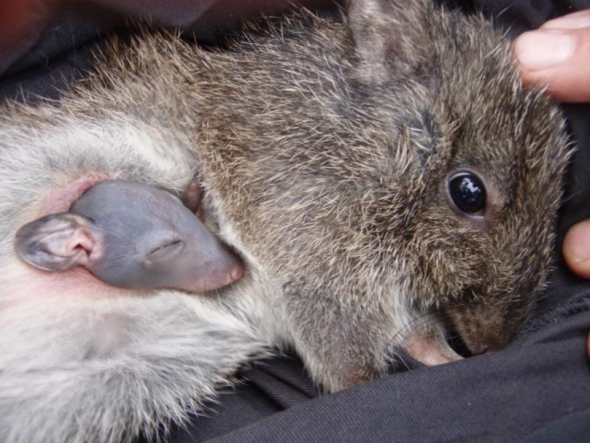
Endangered Species Monday | Potorous gilbertii
This Monday’s (ESP) post, I’ve decided to document a little more on Australia’s wildlife. This Monday I have dedicated this post to one of Australia’s most endangered marsupials. Commonly known as the Gilbert’s Potoroo. (Image Credit Parks and Wildlife Australia).
Identified as the worlds ‘rarest marsupial’, the species is scientifically known as the Potorous gilbertii. Listed as (critically endangered) the species was primarily identified back in 1841 by Dr John Gould FRS - 14 September 1804 – 3 February 1881) who was a British ornithologist and bird artist. He published a number of monographs on birds, illustrated by plates that he produced with the assistance of his wife, Elizabeth Gould, and several other artists including Edward Lear, Henry Constantine Richter, Joseph Wolf and William Matthew Hart.
Dr Gould has been considered the father of bird study in Australia and the Gould League in Australia is named after him. His identification of the birds now nicknamed “Darwin’s finches” played a role in the inception of Darwin’s theory of evolution by natural selection. Gould’s work is referenced in Charles Darwin’s book, On the Origin of Species.
Life hasn’t been at all easy for the P. gilbertii. It was only back in 2012 that conservation and environmental scientists (rediscovered) the species of which it was believed the marsupial had gone completely extinct within the wild. Endemic to Australia there is very little known in relation to when threats came about, increased and decreased. However I can state now; as small as populations are known - P. gilbertii’s populations are ‘currently stable within the wild’.
While though populations are stable, there are only thirty to forty actually known to be living within their endemic wild, so there is still a large amount of concern for the worlds most endangered marsupial. Back in early 1980’s the species had been listed as (completely extinct within the wild after studies from the 1800’s turned up nothing). Fortunately though environmental scientists went on the prowl and were not under any circumstances ready to write this species off whatsoever. They were technically looking for an animal that hadn’t been seen since the 1880’s-1990’s. Their work though eventually paid off.
“THEN CAME A BREAK THROUGH IN 1994”
Environmental scientists come 1992-1993 were ready to write the species off, call off all explorations and projects that were aimed at hopefully rediscovering the species. Fortunately though the Australian Parks and Wildlife Service persisted - and come 1994 a spotting was recorded. After so many years believing the Gilbert’s Potoroo had gone extinct, scientists discovered an extremely small population - to the joy of many. Finally there was hope, and today the species remains under full governmental protection.
Native to South-western and Western Australia the remaining populations was taken by three collectors between 1840 and 1879 in the vicinity of King George’s Sound (Albany), but exact locations are unknown. Skeletal material is common in cave deposits between Cape Leeuwin and Cape Naturaliste. Sub-fossil skeletal specimens have been located in coastal sand dunes between these localities. It is currently restricted to Mt. Gardner promontory in Two Peoples Bay Nature Reserve.
The entire population (consisting of 30-40 mature individuals) as explained above remains inhabits the Two Peoples Bay Nature Reserve of which they enjoy protection from the local parks wildlife board. While populations are identified as extremely small, mother will give birth to either 1-2 babies every year, normally its 2 babies. Like kangaroos the species has the ability to keep a second embryo in a state of diapause while the first embryo is growing. If the first baby does not go to term, a second baby starts growing right away.
Check out the Gilbert’s Potoroo Action Group by clicking this link
Diapause is considered a rare phenomena - especially in kangaroos, although its been witnessed quite a lot over the past few years by European, British and Australian Zoologists. The last diapause event (that I’m aware of) was witnessed at the Taronga Zoological Gardens in Australia. You can read the story >here.< The gestation period for Gilbert’s potoroo is unknown, but is estimated to be similar to the long-nosed potoroo at 38 days.
Since so few are alive today, much of the reproductive cycle for Gilbert’s potoroo remains unknown. However, the main breeding period is thought to be November–December with similar breeding patterns to those of the long-nosed potoroo. Scientists have tried to breed them in captivity, but recent attempts have been unsuccessful, citing diet, incompatibility, and age as possible factors that influenced the lack of reproduction. Reproduction in the wild is thought to be progressing successfully as many females found in the wild are with young.
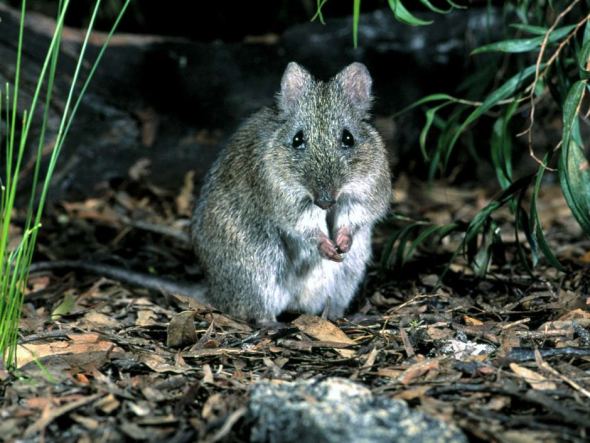
Image: Gilbert’s Potoroo. Photographer Mr Dick Walker.
In 2001, the Gilbert’s Potoroo Action Group was formed to help in the education and public awareness of the potoroo. The group also helps with raising funds for the research and captive-breeding programs for Gilbert’s potoroo. In efforts to protect the remaining population, three Gilbert’s potoroos (one male and two females) were moved to Bald Island in August 2005, where they are free from predation. Since that time, an additional four potoroos have been sent to establish a breeding colony.
THREATS
Fire is the critical threat (present and future) to this species as the Mt. Gardner population is in an area of long unburnt and extremely fire prone vegetation, and a single fire event could potentially wipe out the species (except for the few individuals in captivity and on Bald Island). This species is in the prey size range of both feral cats and foxes, and both are known to exist in the Two Peoples Bay area, thus this species is likely threatened by these predators.
Maxwell et al. (1996) states that the reasons for the decline of the species are unknown. Predation by foxes has probably been significant. Changed fire regimes may have altered habitat and/or exacerbated fox and cat predation by destroying dense cover. Gilbert’s notes record it as “the constant companion” of Quokkas, Setonix brachyurus
Unlike Gilbert’s Potoroo, the Quokka, although declining, persists over much of its pre-settlement range. The difference has not been explained. Maxwell et al. (1996) and Courtenay and Friend (2004), suggest that dieback disease caused by Phytophthora cinnamomi threatens persisting populations by eliminating plant symbionts of hypogeal, mycorrhizal fungi which are the principal food of Gilbert’s Potoroos. Altering vegetation structure and eliminating plants that provide food are direct threats to this species.
For now and based on various accounts, research and up to data documentaries. The species is still in danger. As explained above a single large and sporadic fire within the species habitat - could kill off the entire identified populations, which would be a catastrophe. While there is minimal threat from predators such as foxes and feral cats - this could change. So the need for persistent monitoring is a must. Finally we have disease, with populations being so small at around 30-40, any single disease could like fires wipe the entire species out within a single week.
Within the article above I’ve included various links for your immediate attention and information, as well as a link to the main working group that is helping (and doing all they can) to preserve the species. Furthermore I’ve included a donation link for you to donate to the Gilbert’s Potoroo Action Group. While I’m not entirely sure whether you can volunteer, there is a link on the main website below (highlighted: Volunteer Today). Just click the link, follow the instructions and, I’m confident someone will get back to you as soon as possible.
Volunteer Today
Thank you for reading, please don’t forget after reading to share this article, and hit the like button too.
Dr Jose Carlos Depre Depre PhD. MEnvSc. BSc(Hons) Botany, PhD(NeuroSci) D.V.M.
Environmental & Human Science
Endangered Species Monday: Papilio homerus |Extinction Imminent.
Endangered Species Monday: Papilio homerus
This Mondays (Endangered Species Post) E.S.P, I document again on this stunning species of swallowtail butterfly. I last documented on this amazing species of butterfly two years back, unfortunately conservation actions that were ongoing back then still don’t seem to really be improving the current status of the largest swallow tail butterfly in the Western Hemisphere. Image credited to Dr Matthew S. Lehnert.
Despite the species nearing (complete extinction) within the wild, with a possible extinction likely to occur soon, biologists and conservationists are doing all they can to improve the current status of this beautiful insect, we can only hope for the best, or that the Jamaican Government increases further protection for the species, thus earmarking funding for conservation teams on the ground to preserve our largest Western Hemisphere species of swallowtail.
Endemic to Jamaica, the species was first discovered by Professor Johan Christian Fabricius (7 January 1745 – 3 March 1808) who was a Danish zoologist, specializing in “Insecta”, which at that time included all arthropods: insects, arachnids, crustaceans and others. He was a student of Professor Carl von Linnaeus, and is considered one of the most important entomologists of the 18th century, having named nearly 10,000 species of animals, and established the basis for the modern insect classification.
Professor Johan Christian Fabricius first identified and documented on P. homerus back in 1793. The common name for this swallowtail butterfly is known as the Homerus Swallowtail, which is listed as [endangered]. Back in 1983 the species was first listed as [vulnerable]. Then from 1985-1994 the species was re-listed as [endangered]. Evidence shows from 2007 we almost lost the species, of which conservation press and media pleaded with the public for help, which did in a way increase awareness. Sadly we need more awareness on and about this butterfly.
The specie hosts a wingspan of some fifteen centimeters, the Jamaican swallowtail is said to be the second largest swallowtail of its kind on the planet, with the African swallowtail alleged to be the largest. The species can only be located within the forests of Jamaica, of which habitat loss remains the largest yet significant threat associated with this species of swallowtail butterfly, butterfly collecting is alleged to be the second largest threat. Parasitic wasps also pose a large threat to the P. homerus too.
Back in the 1930’s P. homerus was considered to be somewhat common throughout Jamaica, however, regrettably the species can now only be located within the Blue and John Crow Mountains in eastern Jamaica. Population count is [estimated to be no fewer than fifty individuals], which theoretically makes this super stunning butterfly one of the planets most threatened species of insects.
P. homerus is included on the Convention of International Trade in Endangered Species wild flora and fauna (Cites), of which (all domestic and international trade of this species is strictly illegal). Collection for display and trade is illegal, and finally destruction of the swallowtail butterflies habitat is furthermore strictly ‘forbidden’.
It has been suggested that the species could/may ‘benefit from captive breeding’, more data on this subject can be located hereto http://www.troplep.org/TLR/1-2/pdf005.pdf The caterpillars feed exclusively on Hernandia jamaicensis and H. catalpifolia; both of which also are endemic to Jamaica.
The Giant is a peaceful lover of a quiet habitat and is normally found in areas that remain undisturbed and unsettled for the most part, although due to destruction of its habitat can rarely be found at some cultivated edges of the forests on the island. P. homerus primary and favorite residence is usually the wet limestone and lower montane rain forests, however, it is now isolated to only 2 known locations on the island of Jamaica. The reproduction habits are not well known but like most of its fluttering cousins, it feeds on leaves and flowers where it also breeds and lays eggs that develop on the host plants.
P. homerus future remains critical, and its quite likely that we’re going to see yet another extinction occur sometime very soon. As much as I hate to say this, I do honesty believe that a complete wild extinction may occur in no fewer than 1-2 years (if that). However I believe based on the current populations, data, and habitat destruction, that extinction will occur sooner than that. I am not aware (as explained) of any captive breeding programmes, which if such projects are not undertaken now, we’ll see the species gone for good in under a year.
Image: P. homerus caterpillar.
Thank you for reading, and please share this article to create more awareness relating to the Jamaican swallowtail, and lets hold our breath and pray to almighty God that somewhere out there, wherever God may be, a miracle may occur.
Dr Jose C. Depre
Follow me on Twitter here: https://twitter.com/josedepre11
Follow our main Facebook page here: https://www.facebook.com/InternationalAnimalRescueFoundationAfrica/
International Animal Rescue Foundation and Environmental News & Media are looking for keen, enthusiastic, environmental and animal lovers to write alongside us. We do not pick sides, and show both sides to every-story. We like to take a more middle stance, rather than a one-sided stance. If you would like to spare an hour of your time, per week, voluntarily writing for us, or your own environmental/animal welfare related issue please contact us via the contact box below.
Please note that we have since moved our main communications website to a new and more professional server that will be hosting everything from real life news, real time projects, world stories, environmental and animal rescues and much more. International Animal Rescue Foundation is a 100% self funded environmental company. While we don’t rely on donations, you can make a donation to us via our main Anti Pet & Bush Meat Coalition organisation page.
Have a nice day.
What Part of Unethical Conservation Don’t You Understand? | Endangered Species Monday Special.
ETHICAL OR UNETHICAL
Last week we wrote an article in relation to the GoEco student/tourist travel firm, and the Zanchieta Wild Cat Farm. As usual we came under some pretty heavy criticism as apparently we were yet again in the wrong. Within many of the emails that we have received, students have literally blasted us for depicting themselves holding, petting or interacting with African predator cats, many of them cubs that seem to have no mother insight, and could be re-rehabilitated into the wild to boost wild predator populations up.
Back in 2015 from January to December we rolled out yet again another mass educational and awareness campaign aimed at mainly students and overseas tourists that paid up to $1,200USD for a two week visit to the many petting farms, lodges and resorts on the African continent, that was projected onto our main Facebook platform.
I.A.R.F.A’s educational and awareness campaign (2015) saw over 200 students give up this practice (one of many articles you can read here). Furthermore Zebula Golf and Spa Club that was hosting lion petting activities withdrew the practice, and removed adds from their main website. An African zoological garden removed its advertisement for cheetah petting, thus later ending their petting experiences, and finally a painter and artist that was promoting such activities eventually stopped.
The campaign also saw a decline in profit in relation to the Ukutula Game Lodge, and customer star rating, and less students visiting from 2014-2015. Amanzi Travel located within the United Kingdom have also allegedly withdrawn their lion petting advertisements focusing more on ethical conservation. (Amanzi Travel are still the focus of our attention though). The list goes on, and frankly we’re not going to stop until these practices are ceased immediately.
From 2014-2015 the organisation Blood Lions pounded the streets and cinemas (internationally) in relation too the petting and canned hunting industry which has seen quite a significant response from the petting and hunting fraternity too). In the wake of much controversy France has implemented an immediate ban on lion trophies being brought into the country. Now PHASA are at the throats of (Sapa, reported by Blood Lions) demanding the South African Predator Association immediately responds to the canned hunting problem that’s sparked fireworks around the globe. (See video below).
Unfortunately, despite the mass effort that we and others have placed into these projects, students, tourists, even trainee zoologists and veterinarians still thrash it out with us, believing that what they are participating in, is all good fun and doesn’t do the animal any harm whatsoever. Below are just a handful of the lame excuses that we read every week emailed to us in anger.
LAME RESPONSES FROM TOURISTS / PREDATOR PETTING
“None of these cubs were harmed and are all living a peaceful happy life”
“Your information is wrong, petting doesn’t harm the cubs, the cubs don’t have a mother, we’re helping them and their cuddly, so what!”
“Please research your information before posting my image, there is no hunting on this farm whatsoever, leave me alone”
“The image you posted of me misrepresents me, all I was doing was holding the cub for a Facebook photo avatar. I’m doing nothing wrong”.
“Lions are so cute, I can’t wait to go back again”
“They advertise release programs, and I participated in a release program within a fenced in area, none of the animals were harmed, or killed, what’s your problem?”
The above lines are just a handful of lame excuses that we read everyday from tourists, students, petting farms, and alleged predator rehabilitation sanctuaries. Furthermore no matter how much we try to explain, either in basic English or with science - the fact of the matter is this: Many students, tourists and sanctuaries fail to see the damage that they are doing, and contributing too.
Many of the students and tourists that we’ve highlighted as contributing too unethical conservation also scold us for using their images, stating that we’re misrepresenting them holding or petting a “predator cub”. So we’re going to try things a little differently. Back to basics. Below we’ve included a number of images, and under them images we’ve written a brief extract in relation to what’s wrong with each image/ real life scenario. However before we start, lets take a look at what real ethical conservation is within the “captive breeding and release industry”.
Image: Basel Zoological Gardens.
The image above was taken at Basel Zoological Gardens, and as you can see mother, father and three young cubs are happily strolling in the park on a fine late Spring day of (2015). There are no tourists, students or even the hint of petting, interaction, cuddling or manhandling on show here. Mother’s Oka and Uma gave birth to their cubs on May 28th, and June 15th (2015).
Many people may be asking, why are lions being bred and reared within a foreign non-African zoo? The answer to that is simple. Lions are listed as vulnerable (IUCN Red List population map), and while there may be many lions in countries such as South Africa where security is more tight. North and West African lions are practically extinct. Southern Africa is probably one of very few regions now on the African continent that holds more “larger populations”. Unfortunately within the past twenty years Africa has seen a staggering decrease of lion populations by over 30-50%. (See video below.)
Zoo Basel supports the Big Life Foundation, which works in the Amboseli-Tsavo ecosystem in Kenya to protect the Lions. The Zoo is also a participant in the EAZA Endangered Species Breeding Programme for African Lions. This means that every-single lion you see within a zoo that’s part of the EAZA Endangered Species Breeding Programme will eventually be released into the African wild, they’ll not be kept for photography purposes, or to interact with.
For release programme’s to be successful human interference must be kept to a bare minimal. You’ll not see any petting, interaction, man-handling or public photography exploitation going on here. EAZA’s Endangered Species Breeding Programme is what we refer to as “ethical conservation within captivity”, and there is much evidence in relation to EAZA’s working projects too.
UNETHICAL CONSERVATION PRACTICES
Below are prime examples of “unethical conservation practices”. From America too the continent of Africa you’ll not see EAZA’s Endangered Species Breeding Programme allowing this type of behavior. The reasons why you’ll not see such behavior played out within anyone of EAZA’s projects is listed below for your information in plain English.
GENERAL PETTING
Image: Sarah Haley lion petting United States
Back in 2012 Sarah Haley from Fayetteville, Arkansas, United States visited the Wild Wilderness Through Safari. Sarah’s reasons for visiting was quite simple. “I mostly went to play with the lions”. As one can see these lions are very young, and as normal there seems to be no mother or father in sight. What Sarah doesn’t realize is, the mother would have had her young ripped away from her at a young age, just so tourists and students can play petting.
Mother and cub[s] would have been left in quite an emotional state, suffering psychological trauma, and would have pined for one another. Its more or less the same behavior a new born baby and mother will play out when separation occurs. Did it make you feel good Sarah knowing that you was holding a pining mothers cub that simply wanted to behave like any normal human or animal mother?
There doesn’t appear to be any-form of breeding programme in operation at this alleged zoo either. Furthermore this cat will never be released into the wild, because all of its natural instincts have been removed by the human, and imprinted from the human onto the cub. Yet on the African continent we’ve lost over 50% of our lion populations. There doesn’t seem to be any form of hunting advertised, however we are somewhat suspicious here as to why so many cubs are being reared at this zoo, and what the so called zoo’s actual intentions are.
MISHANDLING
Image: Unidentified male at the Zanchieta Wild Cat Farm
Every month we bring into question many safaris, big cat projects, lodges and zoos. Many of them do not participate in hunting, while others are more than “questionable in relation to their mission statement and hunting”, and what they are actually projecting into the public domain (which most of the time doesn’t support their mission statement).
Furthermore contradictions from the owners in regards to their companies mission statement are rampant among such alleged rehab and non-breeding facilities. The image above seems pretty innocent, and quite adorable to most. The image was posted onto the Zanchieta Wild Cat Farm Facebook page of which the Zanchieta Wild Cat Farm has venomously protected as innocent.
Zanchieta have even gone to great lengths in the past week basically stating that were totally wrong, and everything that we’ve located in relation to their company (above and below) is more than legitimate. An insult that we did read stated: “We (Zanchieta Wild Cat Farm) know that this post by I.A.R.F. was done with good intentions, from people who, like us, love animals and fight for their rights”. We do indeed love animals hence why this article is proving wrongdoing and unethical conservation practices. I.A.R.F.A do not under any circumstances support such activities nor will we promote them either. (Please continue reading).
What the young unidentified male seems to be forgetting is that this young cub “may” have been removed from his/her mother at the prime milking age of three weeks old. PAAZAB’s Husbandry and Veterinary Guide states: The cub should also be supported under its bottom with the other hand, cubs must be supported correctly as to not injure the young developing cub. Further to this we all know that cubs aren’t exactly hygienic like their adult mothers and fathers. Regardless of how much Zanchieta Wild Cat Farm defends themselves, the images projected onto their Facebook page are clear signs of “exhibiting to profit from money”. The worst is to come.
Cubs this age want roam, explore, test their young muscles to develop coordination, and sleep for extended periods of time without interruption. They dislike being handled. While Zanchieta Wild Cat Farm states that they protect, rescue and rehabilitate, this behavior is neither protecting the cub, or (at the least) trying to rehabilitate this young cub into the Asiatic wild where the number of tigers are about 3,200 if that remaining in the wild.
Zanchieta Wild Cat Farm also hosts a number of lions identified as the (Timbavati white lions). This area of alleged predator conservation has been a great focus of concern to us, Timbavati white lions are practically extinct. There is said to be more white lions in captivity than in the wild. Meanwhile within the wild there is alleged to be no fewer than 13-20 individuals if that. So why is this predator rehab farm and rescue not helping to support white wild populations with captive breeding programmes? (See video below)
The owner of Zanchieta states via her website “I have never and never will breed or raise any BIG CAT at Zanchieta for onward selling to a third party. Our white lion pride has grown from the original male and female pair to five lions and these lions will never leave Zanchieta”. We believe this statement was written back in 2010 when the main domain and site was formed and registered.
NO THREATENED SPECIES RELEASE PROJECTS
Image: Timbavati white lion cub 2014.
Image: Timbavati white lion cub (new born) 2014.
The Zanchieta owner states: “No further natural breeding will occur as the females are on contraception programs. Our two male brown lions and our brown lioness were purchased as cubs and have never been allowed to breed. They too will never leave Zanchieta.” That statement has been on the main Zanchieta website since 2010, yet the lady is not prepared to release these lions into the wild via ethical conservation projects. Timbavati white lions are as explained (critically endangered), so this statement is very questionable.
Again where is the mother, but more importantly why is Zanchieta stating that none of her lions will be allowed to leave the farm? That’s a classical sign of unethical conservation for reasons that we do not fully understand. This lion as one can see (above) is only a few days old. Furthermore as the owner states none of the lions will be allowed to leave the farm.
If you are familiar with the sub-species of the Panthera leo krugeri, you’ll also know that their populations within the wild are dwindling. So theoretically any good “rescue and rehabilitation project” that states they’re not breeding (when they clearly are), would try to improve Panthera leo krugeri populations within the wild like EAZA’s Endangered Species Breeding Programme. So in our (expert opinion), this farm is nothing more than a breeding and captive facility. Indeed there are some release projects ongoing however as the owner states (no lions leave).
So instead students, tourists and volunteers can all help contribute to (nothing). That in our opinion is a complete waste of money, money that could be spent elsewhere on actual breeding and release projects to sustain threatened populations of predators.
ANIMAL ATTACKS
Image: Chameleon Village Lion Park
Whenever we explain to tourists and students about the petting and interaction industry, they’ll often absorb only a certain amount of information (in most cases), which is why education needs to focus more on every aspect of this industry rather than just hunting. Many Non-Governmental Organisations, and “anti hunting groups” out there, will categorically state on locating a petting/breeding farm, that hunting is the major player regarding their find. Most of the farms, lodges and sanctuaries that we’ve located aren’t actually connected to hunting whatsoever.
So when a tourist or student hears them words I.e. hunting is not ongoing, they automatically believe that all is okay, we’ve got our wires crossed, and we’re simply trying to tar the name of a farm or lodge. International Animal Rescue Foundation Africa researchers every single piece of detail on all industries and practices that we do not support practicing unethical conservation. That includes petting, disease, hunting, abuse, exploitation, and failure to keep to promises (I.e): release programmes, or helping increase threatened species in the wild.
Meet Mr Hennie Pio from South Africa. The image above looks very innocent again, and both the visitor and lioness seem pretty much laid back. Tourists need to remember that predators are like cats and dogs, they all have deeply embedded within their genes (hunting and predator behaviors). For E.g. I once owned a Springer Spaniel rescued as a puppy.
That wee dog was domesticated like any other dog into an adult dog. A few years into life and on a long walk, my pet dog jumped the lead, and naturally went after hens and chickens killing three instantly with a single bite to the neck. Yet the dog hadn’t seen a chicken or hen before, nor had she been raised to hunt. The same applies to lions, tigers, cheetahs, leopards, and jaguars Etc. Just because they’ve never hunted naturally in the wild, and had humans imprint their natural behaviors onto them, doesn’t for one single minute mean that, that animal will not attack you.
Listed below are real life captive predator attacks that left their owners or keepers, tourists and visitors with life threatening injuries or in some cases death did occurred.
WHEN CAPTIVE PREDATORS ATTACK
Jan 21, 2016 Australia: A 12 year old tiger has attacked a keeper at an Australian zoo founded by the late Steve Irwin. The incident, which took place Thursday morning at the Sunshine Coast’s Australia Zoo, left 41-year-old Che Woolcott with “significant puncture wounds” to his head and forearm, according to local media reports. He was treated at the scene before being transferred to the hospital.
Nov 29 2015 Malta: Ħal-Farrug zoo was closed by its owners after a tiger severely injures a 3 year old boy. A spokesman for the zoo said the incident happened when the two handlers were walking the “friendly” tiger, which they had raised, outside its cage since it had been slightly unwell. The tiger was lying on the floor when the incident happened. Upon seeing the animal, the boy ran towards it, prompting the tiger to raise its paws, lashing the child in the face in the process, the spokesman said.
Jun 1, 2015 Johannesburg, SA: Katherine Chappell, 29, a visual effects artist for Game of Thrones, was killed and her tour guide seriously injured in an attack by a lioness at the Lion Park near Lanseria. The two people were travelling in the car with their windows open. It’s understood a lioness jumped through the open window, biting the woman who was in the passenger seat. The driver, a tour guide, was badly injured while attempting to free the woman from the animal’s grasp. The park’s Scott Simpson said, “There was a car driving to the lion camp and the lioness came through the window and it bit the tourist. The ambulance arrived quite soon but the lady has passed away.” Three months ago an Australian tourist was bitten in the thigh while driving though the park, also with his window down.
Please view the video below which shows the worlds top ten predator on human attacks, Mr Hennie Pio is in our opinion a very lucky man, like most of the students, tourists and visitors that man-handle allegedly “friendly hand reared predators”. They’re only friendly if they want to be. When you place yourself within a predators environment your acting irresponsibly, furthermore if that animal attacks you, its very likely the animal will be shot dead.
Lastly if your lucky to walk away with minor or serious injuries its highly unlikely that your insurance will cover you, and you have very little chance of receiving compensation - because you placed yourself in that predators environment.
ZOONOTIC DISEASES
Image: Helping Hands for Underprivileged Children
While we all like to visit animal shelters, and provide a helping hand, one will find that some animal shelters and farms in the Western Hemisphere will point out to you the notices that inform you not to pick the animals up, touch the animals, feed them and always ensure that your hands are washed should you come into contact with animals. The reasons for these “polite notices” is to ensure you do not fall ill with anyone of the known zoonotic diseases that are fatal in some cases.
The organisation identified (above) as Helping Hands for Underprivileged Children is where the image above derives from (click the link above that’ll direct you too the Facebook image). The image was picked due to myself being a parent, and because I know just how easy it is for a child to unknowingly place their hands within the mouth dozens if not hundreds of times a day. The data below we do advise you take seriously.
When zoonotic diseases pass from animals to humans, pandemics can result. When a pathogen leaps from some nonhuman animal into a person, and succeeds there in making trouble, the result is what’s known as a zoonosis.
The word zoonosis is unfamiliar to most people. But it helps clarify the biological reality behind the scary headlines about bird flu, SARS, other forms of nasty new disease, and the threat of a coming pandemic. It says something essential about the origin of HIV. It’s a word of the future, destined for heavy use in the 21st century.
About 60 percent of all human infectious diseases currently known are shared between animals and humans. Nearly all zoonotic diseases result from infection by one of six kinds of pathogen: viruses, bacteria, protozoans, prions, fungi, and worms. Toxocariasis is a mild zoonosis caused by roundworms; you can get it from your dog, cat or in this case a predator. But fortunately, like your dog, cat or predator, you can be wormed. On some farms the owners lie to the public, and there is no way of telling if these animals are treated. Should the animal not be treated as the owners have advertised - your insurance doesn’t cover this either. Your unlikely to be compensated, and you could spend anything from 2 months to 1 year+ off work, or out of action.
Fore more information on zoonotic diseases in lions click the link below. here http://cbs.umn.edu/research/labs/lionresearch/research/diseases
We have deliberately left out all mention of hunting within this article, because frankly many tourists, students and visitors that visit predator farms seem to believe that if hunting is not seen as the “major problem”, then all is as explained pretty much okay. The petting and interaction industry can at times be directly related to hunting, however there are as seen above other issues that you need to take into consideration over hunting.
If you believe an image that we have posted “misrepresents you”, then just stop and think how that individual predator cat thinks about you misrepresenting them as a cuddly “pet”. International Animal Rescue Foundation Africa supports all EAZA’s breeding projects, reputable projects that do take in predators that are unable to be released into the wild, I.e: circus, rescues, domestic rescue Etc. We are able to view the lies and contradictions within each alleged rescue, lodge, farm or sanctuary and can if required go to great lengths to prove “unethical conservation practices are being played out here”, with more than sinister motives possibly attached.
This article hasn’t been written to attack, or place blame, but more point to where problems are occurring within the predator breeding and petting industry. If your allegedly rescuing, and rehabilitating then please print and practice just that. If your not breeding and have stated all your animals are on contraceptives, then keep to that promise. If you knowingly understand ethical conservation and really do plan on helping wildlife in their endemic wild, then please practice that. Please do not mislead the public into thinking that your indeed 100% ethical - as we will find you, and highlight them problems always steering the public into the correct conservation path.
If you feel that you’ve been led astray and would like to visit and participate in ethical conservation, please click the links below.
EAZA: http://www.eaza.net/about-us/vacancies/
WORKING ABROAD: http://www.workingabroad.com/projects/south-africa-lion-volunteer
PROTRACK: http://www.protrackapu.co.za/news-blog
BIG CAT RESCUE: https://bigcatrescue.org/get-involved/volunteer/
RHINO ORPHANAGE: https://www.helpgoabroad.com/volunteer-abroad/specialist-rhino-orphanage-and-rehabilitation-centre-2306/
Thank you for reading.
Chief Environmental Officer
Dr Jose C. Depre.

